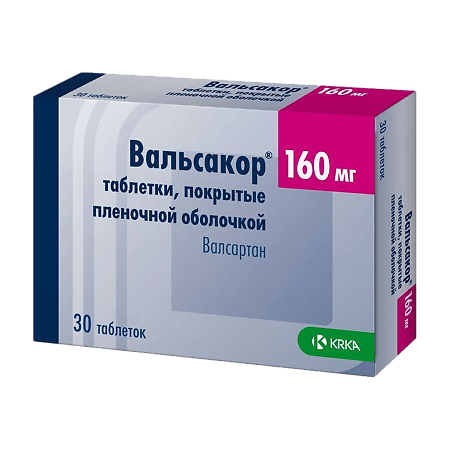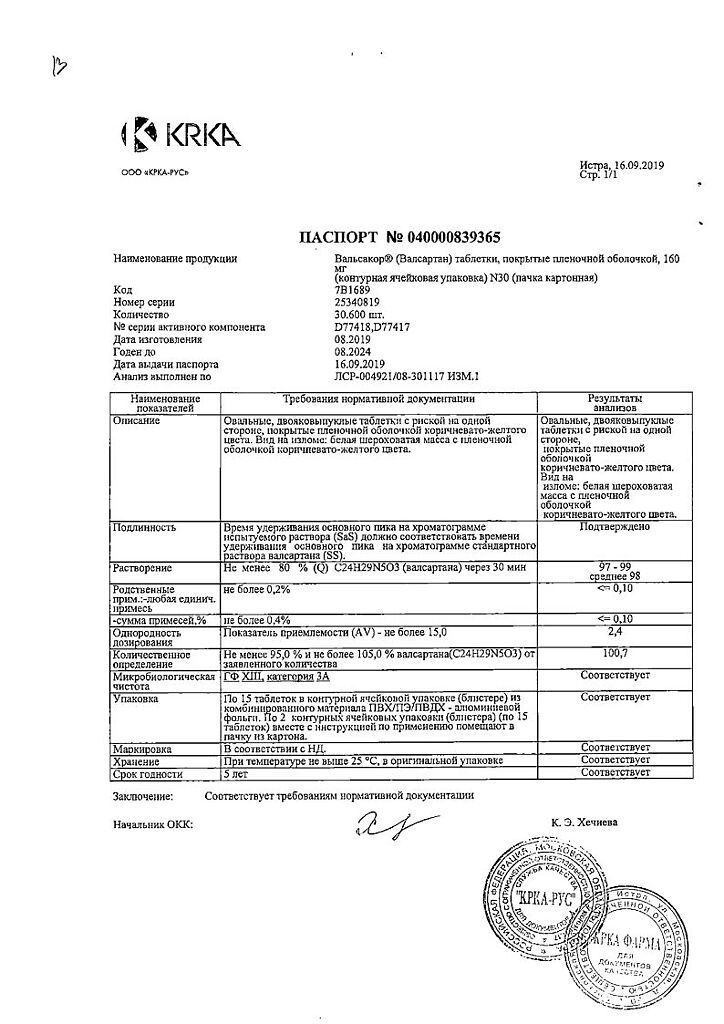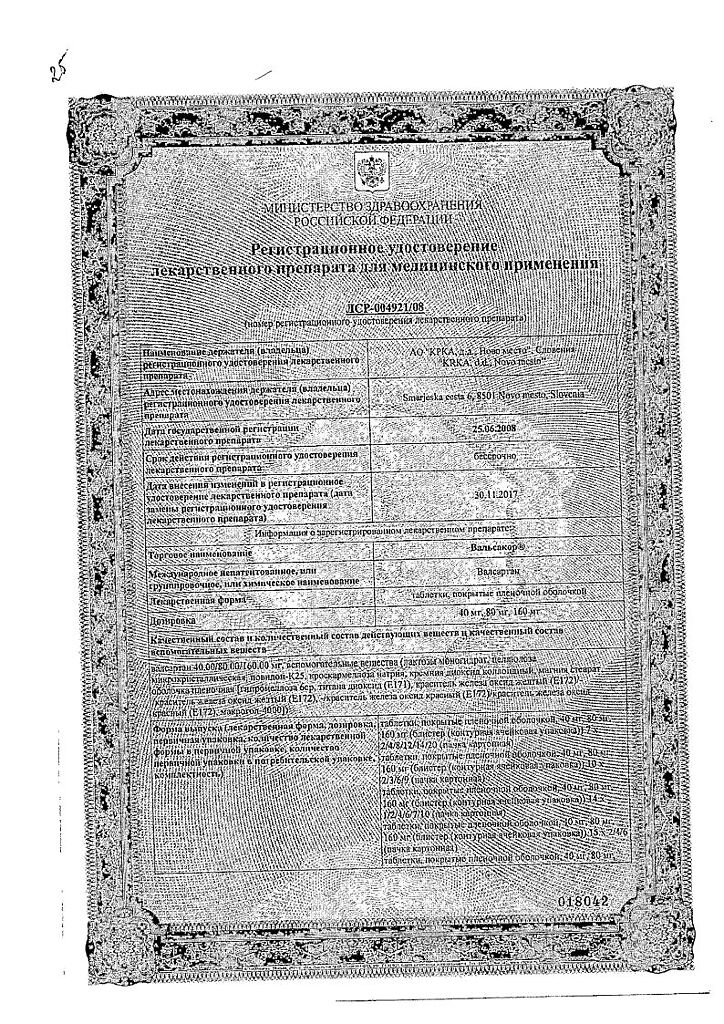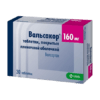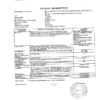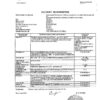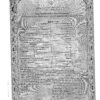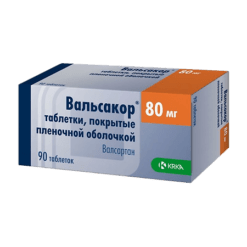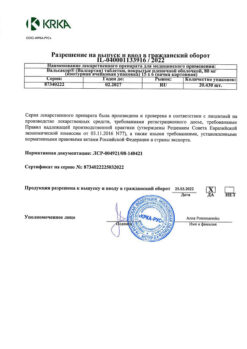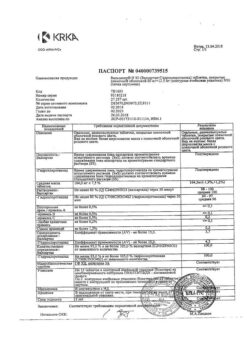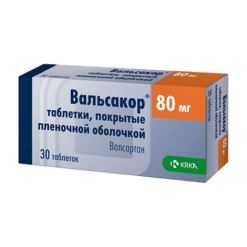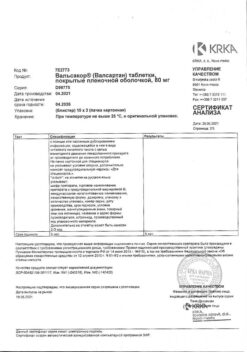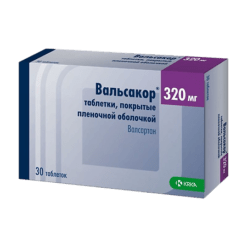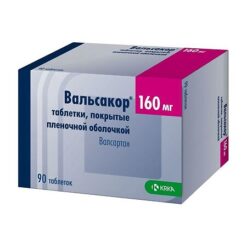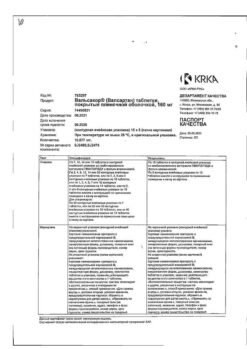No products in the cart.
Valsacor, 160 mg 30 pcs
€12.28 €10.74
Description
Myocardial infarction, Hypertension (high blood pressure), Heart failure
Patients over 18 years
- Arterial hypertension.
- Chronic heart failure (II-IV functional class according to NYHA classification) in complex therapy (against standard therapy) in patients who do not receive ACE inhibitors.
- increase survival of patients after acute MI complicated by left ventricular insufficiency and/or left ventricular systolic dysfunction with stable hemodynamic parameters.
Patients from 6 to 18 years
- Arterial hypertension in 6- to 18-year-olds.
.
Active ingredient
Active ingredient
Composition
Composition
(per 1 film-coated tablet, 40 mg):
Kernel:
Active substance:
Valsartan 40.00 mg
Auxiliaries: lactose monohydrate, microcrystalline cellulose, povidone-K25, croscarmellose sodium, colloidal silicon dioxide, magnesium stearate
coating film: hypromellose 6cr, titanium dioxide (E171), iron oxide yellow dye (E172), macrogol-4000
(per 1 film-coated tablet, 80 mg):
Kernel:
Active substance:
Valsartan 80.00 mg
Auxiliaries: lactose monohydrate, microcrystalline cellulose, povidone-K25, croscarmellose sodium, colloidal silicon dioxide, magnesium stearate
coating film: hypromellose 6cr, titanium dioxide (E171), iron oxide red dye (E172), macrogol-4000
(per 1 film-coated tablet, 160 mg):
Kernel:
Active substance:
Valsartan 160.00 mg
Auxiliaries: lactose monohydrate, microcrystalline cellulose, povidone-K25, croscarmellose sodium, colloidal silicon dioxide, magnesium stearate
Film coating: hypromellose 6cp, titanium dioxide (E171), iron oxide yellow dye (E172), iron oxide red dye (E172), macrogol-4000
How to take, the dosage
How to take, the dosage
Orally, regardless of meal times.
Patients over 18 years of age
Arterial hypertension
The recommended starting dose of Valsacor® is 80 mg once daily, regardless of the patient’s race, age, or gender. The antihypertensive effect develops within 2 weeks and reaches its maximum after 4 weeks. In patients who do not achieve adequate BP control, the daily dose of valsartan may be gradually increased to a maximum daily dose of 320 mg.
The use of diuretics (hydrochlorothiazide) as well as concomitant use of other hypotensive agents is possible to further decrease BP.
Chronic heart failure
The recommended starting dose of Valsacor® is 40 mg 2 times daily. The dose should be gradually increased over at least 2 weeks to 80 mg twice daily, and if tolerated well, to 160 mg twice daily. The maximum daily dose is 320 mg in two doses. In this case, it may be necessary to reduce the dose of concomitantly taken diuretics.
Concomitant use with other medicinal products for treatment of CHF is possible. However, concomitant therapy with drugs of three classes: valsartan, ACE inhibitors and beta-adrenoblockers is not recommended.
The evaluation of patients with CHF should include monitoring renal function.
Application after acute myocardial infarction
The treatment should be started 12 hours after acute MI with stable hemodynamic parameters. After an initial dose of 20 mg 2 times daily (½ tablet of 40 mg), the dose of Valsacor® may be gradually increased by titration to: 40 mg, 80 mg and 160 mg 2 times daily over several weeks. The maximum daily dose is 320 mg in 2 doses. It is recommended to increase the dose to 80 mg twice daily by the end of the 2nd week, and the maximum target dose of 160 mg twice daily can be achieved by the end of the 3rd month of therapy with Valsacor®. Achievement of the target dose depends on tolerability of valsartan during the dose titration period.
If excessive BP decrease develops with clinical manifestations or impaired renal function, the drug dose should be reduced.
Concomitant use with other drugs, including thrombolytics, acetylsalicylic acid as an antiplatelet agent, beta-adrenoblockers and HMG-CoA reductase inhibitors (statins) is possible. Simultaneous use with ACE inhibitors is not recommended.
The evaluation of patients after acute MI should include monitoring of renal function.
Patients 6 to 18 years
.Arterial hypertension
The recommended starting dose of Valsacor® in children and adolescents 6 to 18 years of age is 40 mg if the child weighs less than 35 kg and 80 mg if the child weighs more than 35 kg. It is recommended that the dose be adjusted to lower blood pressure. Maximum recommended daily doses are shown in the table below. Use of higher doses is not recommended.
body weight
Maximum recommended daily dose
⥠8 kg < 35 kg
80 mg
⥠35 kg < 80 kg
160 mg
⥠80 kg ⤠160 kg
320 mg
Cronic Heart Failure and Past Myocardial Infarction
The drug Valsacor® is not recommended for the treatment of CHF and past acute MI in patients younger than 18 years.
Elderly patients
No adjustment of the drug dose in patients over age 65 is necessary.
Kidney function impairment
Dose adjustment in patients with CK more than 10 ml/min is not required. The concomitant use of Valsacor® with aliskiren in patients with moderate to severe renal impairment (CK lower than 60 ml/min) is contraindicated.
Liver function disorder
In patients with mild or moderate impairment of liver function of non-biliary genesis without cholestasis, the drug should be used with caution; daily dose should not exceed 80 mg.
Diabetes patients
Continuous use of Valsacor® with aliskiren in patients with diabetes.
Interaction
Interaction
Double blockade of the renin-angiotensin-aldosterone system
In some patients, dual RAAS blockade was accompanied by the development of arterial hypotension, syncope, hyperkalemia, and impaired renal function (including ARF).
The concomitant use of ARA II, including valsartan, with drugs that affect the RAAS, such as ACE inhibitors or aliskiren, is not recommended and BP, renal function, and plasma electrolytes should be monitored closely if this therapy is necessary.
Concurrent use of valsartan with aliskiren and drugs containing aliskiren is contraindicated in patients with diabetes and/or moderate to severe renal function impairment (GFR less than 60 mL/min/1.73 m2 body surface area) and is not recommended in other patients.
The concomitant use of ARA II with ACE inhibitors is contraindicated in patients with diabetic nephropathy and is not recommended in other patients.
Simultaneous use is not recommended
Lithium
Simultaneous use with lithium preparations is not recommended because a reversible increase in plasma lithium concentrations and an increase in its toxic effects are possible. The risk of toxic manifestations associated with the use of lithium preparations may be further increased when concomitant use with the drug Valsacor® and diuretics. If simultaneous use with lithium preparations is necessary, the lithium concentration in blood plasma should be monitored carefully.
Kalice-saving diuretics (spironolactone, eplerenone, triamterene, amiloride), potassium preparations, potassium-containing supplements
Special Instructions
Special Instructions
Hyperkalemia, concomitant use of potassium-saving diuretics, potassium-containing drugs, potassium supplements or other drugs that can increase plasma potassium content (e.g., heparin), mild to moderate liver function abnormalities of non-biliary genesis without cholestasis phenomena, severe renal dysfunction (CK less than 10 ml/min) (no clinical data), renal dysfunction in patients aged 6 to 18 (CK less than 30 ml/min), including those on hemodialysis, hyponatremia, diet with restriction of table salt intake, conditions accompanied by decreased circulating blood volume (CBC) (including diarrhea, vomiting), bilateral renal artery stenosis or stenosis of the artery of a single kidney, conditions after kidney transplantation, primary hyperaldosteronism, in patients with CHF of III-IV functional class according to NYHA, patients whose renal function depends on the state of renin-angiotensin-aldosterone system (RAAS), aortic and/or mitral valve stenosis, hypertrophic obstructive cardiomyopathy (HACMI), in patients with hereditary angioedema, or angioedema against the background of previous therapy with ARA II or ACE inhibitors.
The use of ARAs II, including valsartan, concomitantly with ACE inhibitors is not recommended because their concomitant use has no advantage over valsartan or ACE inhibitor monotherapy with respect to overall mortality rates.
It is contraindicated in children under the age of 6 years for arterial hypertension and under 18 years for other indications.
Patients 6 to 18 years
.Arterial hypertension
The recommended starting dose of Valsacor® in children and adolescents 6 to 18 years of age is 40 mg if the child weighs less than 35 kg and 80 mg if the child weighs more than 35 kg. It is recommended that the dose be adjusted to lower blood pressure. Maximum recommended daily doses are shown in the table below. Use of higher doses is not recommended.
body weight
Maximum recommended daily dose
⥠8 kg < 35 kg
80 mg
⥠35 kg < 80 kg
160 mg
⥠80 kg ⤠160 kg
320 mg
Cronic Heart Failure and Past Myocardial Infarction
The drug Valsacor® is not recommended for the treatment of CHF and past acute MI in patients younger than 18 years.
Elderly patients
No adjustment of the drug dose in patients over age 65 is necessary.
Kidney function impairment
Dose adjustment in patients with CK more than 10 ml/min is not required. The concomitant use of Valsacor® with aliskiren in patients with moderate to severe renal impairment (CK lower than 60 ml/min) is contraindicated.
Liver function disorder
In patients with mild or moderate impairment of liver function of non-biliary genesis without cholestasis, the drug should be used with caution; daily dose should not exceed 80 mg.
Diabetes patients
Simultaneous use of Valsacor® with aliskiren in patients with diabetes is contraindicated.
Hyperkalemia
Caution should be exercised when concomitantly using potassium-saving diuretics (spironolactone, eplerenone, triamterene, amiloride), potassium drugs, potassium-containing salt substitutes, or other drugs that can increase plasma potassium (such as heparin). Regular monitoring of plasma potassium content is necessary.
Kidney function impairment
In patients with impaired renal function, the drug dosage should not be changed. Since there are no data on the use of the drug in severe renal insufficiency (CKR less than 10 ml/min or 0.167 ml/s) and in patients on hemodialysis, in such cases the drug is recommended to be used with caution.
Simultaneous use of valsartan with aliskiren in patients with moderate to severe renal impairment (CK lower than 60 ml/min) is contraindicated.
Liver function impairment
In patients with mild to moderate hepatic dysfunction without cholestasis, Valsacor® should be used with caution.
Patients with hyponatremia and/or dehydration
In patients with severe hyponatremia and/or dehydration, such as due to high doses of diuretics, arterial hypotension with clinical manifestations may develop in rare cases at the start of therapy with Valsacor®. Before the start of treatment it is recommended to restore the sodium and/or the blood circulation, in particular by reducing the doses of diuretics.
Renal artery stenosis
The short-course use of valsartan in patients with renovascular hypertension secondary to renal artery stenosis does not cause significant changes in renal hemodynamic parameters, serum creatinine or urea nitrogen concentrations. However, taking into account that other drugs influencing RAAS may increase serum concentrations of urea and creatinine in patients with bilateral renal artery stenosis or artery stenosis of the uniciliary artery, serum creatinine and residual urea nitrogen concentrations should be controlled regularly.
Condition after undergoing kidney transplantation
The safety of Valsacor® in patients who have recently undergone a kidney transplant has not been established.
Primary hyperaldosteronism
Patients with primary hyperaldosteronism are resistant to hypotensive drugs that affect the RAAS, so use of Valsacor® is not recommended in such patients.
Aortic and/or mitral valve stenosis, GOCMP
Valsacor® should be used with caution in patients with hemodynamically significant aortic and/or mitral valve stenosis or with GOCMP.
Period after MI
Simultaneous use with ACE inhibitors is not recommended because it has no additional clinical advantage over monotherapy and increases the risk of adverse events.
The use of valsartan in post MI patients often results in a slight decrease in BP, but discontinuation of therapy due to hypotension is usually not required if the dosing recommendations of the drug are followed.
Therapy with Valsacor® should be initiated cautiously. Evaluation of patients after acute MI should include monitoring of renal function.
The simultaneous use in acute MI with other drugs is possible: thrombolytics, acetylsalicylic acid, beta-adrenoblockers and HMG-CoA reductase inhibitors (statins).
Cronic Heart Failure
In patients with CHF, the simultaneous use of three classes of drugs is not recommended: ACE inhibitors, beta-adrenoblockers, and valsartan, as this therapy did not provide additional clinical benefit, with an increased risk of adverse events. Use in patients with CHF is usually accompanied by a decrease in BP, but treatment rarely requires withdrawal due to hypotension if recommendations for dose selection are followed. Therapy with Valsacor® in patients with CHF should be started with caution. Due to RAAS activity suppression in some patients (for example, in patients with CHF of III-IV functional class according to NYHA classification, whose renal function depends on RAAS state) during ACE inhibitors therapy it is possible the change of renal function: oliguria and/or progressive azotemia development and in rare cases – ARF and/or lethal outcome. Valsacor® blocks angiotensin II receptors, therefore regular monitoring of renal function is necessary in patients with chronic heart failure.
Angioneurotic edema in history
Among patients with angioedema on therapy with Valsacor®, there have been cases of developing angioedema in the history, including on ACE inhibitors. In case of development of angioedema the drug should be immediately discontinued and the possibility of repeated use should be excluded.
Special information about excipients
The drug Valsacor® contains lactose and therefore should not be used in the following conditions: lactose intolerance, lactase deficiency, glucose-galactose malabsorption syndrome.
Due to the possibility of dizziness or weakness when using Valsacor®, caution should be exercised while driving vehicles and engaging in potentially dangerous activities.
Synopsis
Synopsis
Tablets 40 mg: round, slightly biconvex tablets with a ridge on one side, covered with a film coating of brownish-yellow color.
Breakage appearance: white rough mass with brownish-yellow film coating.
Tablets 80 mg: round, biconvex tablets with a ridge on one side, covered with a film sheath of pink color.
Breakage appearance: white rough mass with pink film coating.
Tablets 160 mg: oval, biconvex tablets with a ridge on one side, covered with a film coating of brownish-yellow color.
Breakage appearance: white rough mass with brownish-yellow film coating.
Contraindications
Contraindications
Side effects
Side effects
World Health Organization (WHO) classification of side effect frequency:
very frequently â¥1/10
often ⥠1/100 to < 1/10
infrequently from ⥠1/1000 to < 1/100
rarely from ⥠1/10000 to < 1/1000
very rarely < 1/10000
frequency is unknown cannot be estimated from available data.
The safety profile of valsartan in patients with AH aged 6 to 18 years does not differ from that of valsartan in patients with AH over 18 years.
Arterial hypertension
Blood and lymphatic system disorders:
frequency unknown: decreased hemoglobin, decreased hematocrit, neutropenia, thrombocytopenia.
Immune system disorders:
incidence unknown: hypersensitivity reactions, including serum sickness.
Metabolic and nutritional disorders:
frequency unknown: increased serum potassium, hyponatremia;
Hearing organ and labyrinth disorders:
infrequently: vertigo.
vascular disorders:
frequency unknown: vasculitis.
Respiratory system, thoracic and mediastinal organs disorders:
infrequent: cough.
Gastrointestinal tract disorders:
infrequent: abdominal pain.
Disorders of the liver and biliary tract:
frequency unknown: impairment of liver function, including increased plasma bilirubin concentration.
Skin and subcutaneous tissue disorders:
frequency unknown: angioedema, skin rash, pruritus, bullous dermatitis.
Muscular and connective tissue disorders:
frequency unknown: myalgia.
Kidney and urinary tract disorders:
incidence unknown: impaired renal function and renal failure, increased serum creatinine concentration.
General disorders and disorders at the site of administration:
infrequent: increased fatigue.
The following adverse events have been observed in patients with AH in clinical trials, the causal relationship of which to valsartan administration has not been established: Arthralgia, asthenia, back pain, diarrhea, dizziness, insomnia, decreased libido, nausea, peripheral edema, pharyngitis, rhinitis, sinusitis, and upper respiratory infections.
After acute myocardial infarction and/or in chronic heart failure (
Overdose
Overdose
Symptoms: the main expected manifestation of valsartan overdose is a marked decrease in BP, which may lead to impaired consciousness, collapse and/or shock.
Treatment:symptomatic, it is recommended to induce vomiting and gastric lavage. If the blood pressure decreases significantly: place the patient into the supine position with the legs elevated upward, administer intravenous 0.9% sodium chloride solution. Regular monitoring of heart and respiratory system activity, blood circulation and urine output is recommended. Hemodialysis is ineffective.
Pregnancy use
Pregnancy use
The use of ARA II in the first trimester of pregnancy is not recommended. Administration of ARA II is contraindicated in II-III trimesters of pregnancy because its administration in II-III trimesters of pregnancy may cause fetotoxic effects (decreased renal function, fetal scarcity, delayed ossification of fetal skull bones) and neonatal toxic effects (renal failure, arterial hypotension, hyperkalemia). If the drug was still used in the II-III trimesters of pregnancy, an ultrasound examination of the fetal kidneys and skull bones should be performed.
If pregnancy is planned, it is recommended that the patient be switched to alternative hypotensive therapy, taking into account the safety profile. If pregnancy is confirmed, Valsacor® should be discontinued as soon as possible.
Newborns whose mothers received ARA II during pregnancy require medical monitoring because of the risk of developing arterial hypotension. There are no data on the excretion of valsartan in breast milk. Therefore, discontinuation of breastfeeding or discontinuation of valsartan therapy and transfer to alternative hypotensive therapy should be considered based on safety profile.
Similarities
Similarities
Additional information
| Shelf life | 5 years. Do not use the drug after the expiration date. tab-stops: 45.8pt 91.6pt 137.4pt 183.2pt 229.0pt 274.8pt 320.6pt 366.4pt 412.2pt 458.0pt 503.8pt 549.6pt 595.4pt 641.2pt 687.0pt 732.8pt;"> |
|---|---|
| Conditions of storage | At the temperature not more than 25 °C, in the original package. Keep out of reach of children. |
| Manufacturer | KRKA-RUS, Russia |
| Medication form | pills |
| Brand | KRKA-RUS |
Other forms…
Related products
Buy Valsacor, 160 mg 30 pcs with delivery to USA, UK, Europe and over 120 other countries.

